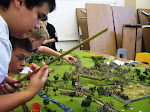This
was the first battle of our SYW campaign.
Prussia is facing an onslaught of enemies as all of the other powers
have united to conquer Frederick’s juggernaut.
The Russians seemed to lose their
fervor once they crossed into Prussian territory, so the first blow was
delivered by the Austrians.
In an
effort to seize the initiative, the Prussians threw three brigades of infantry
into Austrian territory. The Austrians
responded with a better balanced three brigades, one of line infantry, one of
grenadiers and one of cavalry. The
battlefield was a simple affair comprised of a major road, a couple of small
farms and a scattering of fields and woods.
There was plenty of room for maneuver on our 6’ by 4’ table.
The
Prussians led with a brigade of Hessian allies.
Though it was made up mostly of militia and conscripts, it did have a
compliment of cavalry which proved to be of critical importance. On the left flank was Manstein’s infantry
brigade and in support was Hulsen’s brigade.
The
Austrians had Puebla’s line brigade in the center, supported by Von Daun’s
grenadiers on the left and Hadik’s cavalry on the right.
Both
sides issued aggressive orders, so battle was joined straight away. Hadik’s cuirassiers and hussars were ordered
to assault Manstien’s battalions. The
Hessians charged ahead into the deployed lines of Puebla’s infantry while Von
Daun’s grenadiers attempted to move around the Prussian flank. Hulsen was able to change his brigades order
and move to ward off this threat.
The
Hessians were roughly handled by Puebla’s steady infantrymen. Two battalions of Hessian landwehr were
ripped apart by thunderous volleys and waves of canister. But as the battle was drawing to a close, a
regiment of Hessian dragoons managed to endure a blast of grapeshot and close
with the Austrian guns. They won the
mele and then, on the pursuit test, rolled low so as to have to continue the
charge. This was indeed a blessing as
Puebla’s flank was wide open. In the
following turn a battalion was caught in the flank and obliterated before the
dragoons headed back to their own lines to reform.
 |
| The regiment of Hessian hussars can be seen ready to crush the Austrian flank. All those Hessian landwehr did not perish in vain! |
Hadik’s
cavalry attempted to charge Manstein’s men,
but the overall results were dismal.
Though one Prussian battalion was destroyed, the other charges saw very
high rolls empty over half of the saddles of the brave cuirassiers, throwing
them back in defeat.
 |
| The hussars attempted to charge twice, and both times this battalion rolled very high to inflict sufficient casualties to halt the charge. |
 |
| Again, the Prussian's dice were hot, much to the dismay of the Austrian brigadier! |
 |
| Hulsen's men march to protect the right flank. |
The
battle between Von Daun and Hulsen was a stalemate, though the greater number
of casualties were inflicted by the grenadiers.
The Prussians outnumbered the Austrians, but deployed poorly and weren’t
able to take advantage of their numerical superiority.
In the
end, it was clearly a Prussian tactical victory, but a strategic victory for
the Austrians. Another brigade of
Austrian cavalry was close at hand, so the Prussians would not be able to
follow up their victory.
It was
a very fun game. The fact that it took
place within the context of a campaign added a degree of realism that had been
missing from our previous games.
Generally, casualties were moderate, but Hadik lost half of his
cuirassiers and this will surely be felt when the Prussian cavalry is
confronted down the road.



















